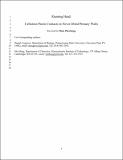| dc.contributor.author | Wang, Tuo | |
| dc.contributor.author | Park, Yong Bum | |
| dc.contributor.author | Cosgrove, Daniel J. | |
| dc.contributor.author | Hong, Mei | |
| dc.date.accessioned | 2016-11-14T19:49:58Z | |
| dc.date.available | 2016-11-14T19:49:58Z | |
| dc.date.issued | 2015-06 | |
| dc.date.submitted | 2015-05 | |
| dc.identifier.issn | 0032-0889 | |
| dc.identifier.issn | 1532-2548 | |
| dc.identifier.uri | http://hdl.handle.net/1721.1/105323 | |
| dc.description.abstract | The structural role of pectins in plant primary cell walls is not yet well understood because of the complex and disordered nature of the cell wall polymers. We recently introduced multidimensional solid-state nuclear magnetic resonance spectroscopy to characterize the spatial proximities of wall polysaccharides. The data showed extensive cross peaks between pectins and cellulose in the primary wall of Arabidopsis (Arabidopsis thaliana), indicating subnanometer contacts between the two polysaccharides. This result was unexpected because stable pectin-cellulose interactions are not predicted by in vitro binding assays and prevailing cell wall models. To investigate whether the spatial contacts that give rise to the cross peaks are artifacts of sample preparation, we now compare never-dried Arabidopsis primary walls with dehydrated and rehydrated samples. One-dimensional 13C spectra, two-dimensional 13C-13C correlation spectra, water-polysaccharide correlation spectra, and dynamics data all indicate that the structure, mobility, and intermolecular contacts of the polysaccharides are indistinguishable between never-dried and rehydrated walls. Moreover, a partially depectinated cell wall in which 40% of homogalacturonan is extracted retains cellulose-pectin cross peaks, indicating that the cellulose-pectin contacts are not due to molecular crowding. The cross peaks are observed both at −20°C and at ambient temperature, thus ruling out freezing as a cause of spatial contacts. These results indicate that rhamnogalacturonan I and a portion of homogalacturonan have significant interactions with cellulose microfibrils in the native primary wall. This pectin-cellulose association may be formed during wall biosynthesis and may involve pectin entrapment in or between cellulose microfibrils, which cannot be mimicked by in vitro binding assays. | en_US |
| dc.description.sponsorship | United States. Department of Energy. Office of Basic Energy Sciences (grant no. DE–SC0001090) | en_US |
| dc.description.sponsorship | National Institutes of Health (U.S.) (grant no. EB002026) | en_US |
| dc.language.iso | en_US | |
| dc.publisher | American Society of Plant Biologists | en_US |
| dc.relation.isversionof | http://dx.doi.org/10.1104/pp.15.00665 | en_US |
| dc.rights | Creative Commons Attribution-Noncommercial-Share Alike | en_US |
| dc.rights.uri | http://creativecommons.org/licenses/by-nc-sa/4.0/ | en_US |
| dc.source | Prof. Hong via Erja Kajosalo | en_US |
| dc.title | Cellulose-Pectin Spatial Contacts Are Inherent to Never-Dried Arabidopsis Primary Cell Walls: Evidence from Solid-State Nuclear Magnetic Resonance | en_US |
| dc.type | Article | en_US |
| dc.identifier.citation | Wang, Tuo, Yong Bum Park, Daniel J. Cosgrove, and Mei Hong. “Cellulose-Pectin Spatial Contacts Are Inherent to Never-Dried Arabidopsis Primary Cell Walls: Evidence from Solid-State Nuclear Magnetic Resonance.” Plant Physiol. 168, no. 3 (June 2, 2015): 871-884. | en_US |
| dc.contributor.department | Massachusetts Institute of Technology. Department of Chemistry | en_US |
| dc.contributor.approver | Hong, Mei | en_US |
| dc.contributor.mitauthor | Hong, Mei | |
| dc.relation.journal | Plant Physiology | en_US |
| dc.eprint.version | Author's final manuscript | en_US |
| dc.type.uri | http://purl.org/eprint/type/JournalArticle | en_US |
| eprint.status | http://purl.org/eprint/status/PeerReviewed | en_US |
| dspace.orderedauthors | Wang, Tuo; Park, Yong Bum; Cosgrove, Daniel J.; Hong, Mei | en_US |
| dspace.embargo.terms | N | en_US |
| dc.identifier.orcid | https://orcid.org/0000-0001-5255-5858 | |
| mit.license | OPEN_ACCESS_POLICY | en_US |
